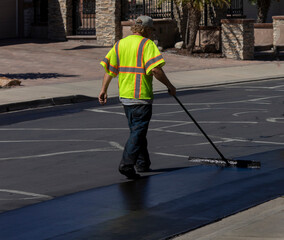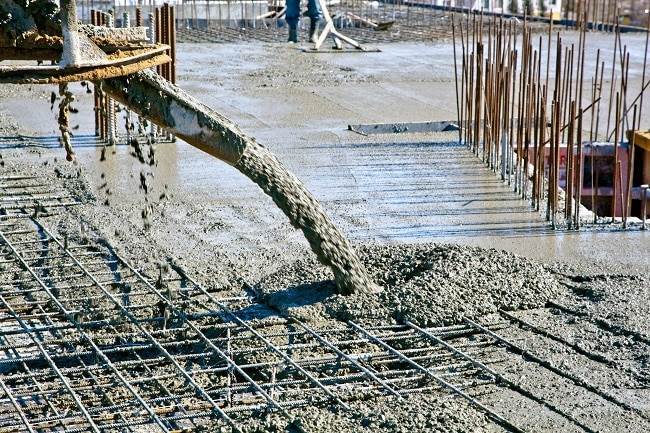Sealcoating is an economical way to extend the life of asphalt pavement. Periodically seal coating your driveway or parking lot will protect against water, the sun’s UV rays, and other degrading elements.

It’s vital that the surface to be sealed is adequately prepped before applying the seal coat. Otherwise, the skin will not cover grease stains or raised spots and may fall into cracks or damaged areas. Visit https://www.pavementsolutionstx.com/ to learn more.
Surface preparation is the foundation of any successful project. Whether you’re coating, bonding, welding, or assembling metal, proper preparation ensures that the topical materials will adhere properly and stand up to the test of time. Industry statistics demonstrate that a high percentage of material failures can be traced back to improper or insufficient surface preparation.
There are six basic steps to the process of cleaning and preparing a surface for sealcoating. First, the surface needs to be thoroughly cleaned. This includes removing any mildew, oil, grease or other contaminants. If left on the surface, these substances will weaken or degrade the new coating, which will then flake or peel off.
After the surface is clean, it must be dried. This can be accomplished using air blowing, scraping, wire brushing, or pressure washing. Regardless of the method used to clean the surface, it must be completely dry before applying any new coats. The reason behind this is that any wet coatings will form small grains as they dry, which will greatly reduce their lifespan and performance.
Once the surface is dry, it must be roughed up to create a good adhesion layer for the new coating. Roughing up the surface also helps to smooth out any cracks and chips in the asphalt. This will increase the longevity of the new surface and make it look better.
Finally, the surface must be primed. Primer can be applied with either an acid-based or an acrylic formula, and is used to provide a base for the sealcoating. It can also be used to fill in any holes or pits in the surface of the asphalt.
There are various methods to use for the surface preparation, depending on the substrate and its environment. Chemical treatments are often the most effective, but can be harsh and toxic to the environment and human beings. Mechanical abrasion and power tools are often the least hazardous and can be more effective than chemicals. MontiPower power tools offer a safer alternative to traditional sandblasting by delivering a more targeted and precise treatment.
Mixing
Sealcoating protects asphalt pavement from damage and deterioration. It extends the life of the surface and helps to keep vehicles on the road longer. It is a relatively inexpensive investment in the long run. It also beautifies the appearance of the pavement, which is important to many property owners. It is recommended that asphalt surfaces be sealcoated every few years.
Sealcoats are generally supplied as concentrates that have to be mixed with water, silica sand and additives prior to application, in accordance with the manufacturer’s recommended mix designs. These mixtures are designed to provide the proper application consistency for the desired performance properties of the final coating. Water used must be clean and potable, low in hardness and iron content to ensure a good coating. The sand and additives used must meet the purity, gradation and chemical specifications required for optimum performance of the final sealcoat.
Workers involved in the sealing process should wear personal protective equipment (PPE). This should include boots, long sleeved work shirts, face masks and safety glasses or goggles. The vapors and particles released during the spraying process can cause a variety of health issues, such as respiratory problems and skin irritation. It is also important to wear rubber gloves and use a paddle attachment to stir the material thoroughly.
The first step is to open the sealcoat system’s 2-inch loading port. This can be done by turning the handle so that it runs non-parallel to the valve. Load the sealer into the spray system at a rate of 2 to 3 gallons per square yard. Thoroughly mixing the product will help reduce clogs and uneven coating. Turning the pails upside down overnight will further aid in the mixing process.
Slurry seals are similar to seal coats but are mixed on-site using a special machine. The slurry contains coarse aggregate like the underlying asphalt and requires eight to 10 hours to cure. This type of pavement surface has a similar look to a freshly laid asphalt driveway and is used for major roadways and highways. It is usually a more cost-effective choice than asphalt overlays.
Applying
Asphalt pavement deteriorates quickly when not maintained, causing it to become faded in appearance and susceptible to water damage. Sealcoating restores a pavement’s original look and extends the life of a driveway or parking lot. It also helps protect from oil and fuel spills, chemical substances that soften the pavement and weather conditions that erode it.
The application process for seal coating involves spraying a liquid material onto the surface of your asphalt. It takes a few hours for the first coat to dry and several hours more before you can use your driveway again.
During the application process, you should keep children and pets away from the area. You should also close off the area to traffic and pedestrians with cones, barricades and warning tape. It is important to do this because you don’t want anyone or anything walking on the newly-sealed surface before it has fully dried.
It is recommended that you sealcoat your pavement every two to three years to maintain the best looking and functioning surface possible. When properly applied, the material will stop water penetration and weather damage and protect your investment for a fraction of the cost of a full asphalt replacement.
When choosing an asphalt sealcoating contractor, be sure to select one that is licensed and insured. They should also provide a warranty on their work. It is a good idea to get several estimates before making your final decision. This will help ensure that you are getting the best value for your money and that you’re working with a reputable company.
Spray application is the most common method of applying asphalt sealer. Workers use a machine that heats the sealant and dispenses it in a stream of liquid. A variety of tip sizes are available to customize the flow and size of the stream. Spray tips with higher gallons per minute (GPM) produce a larger volume of spray and have greater coverage, but may require more precision than those with lower GPM.
Another way to apply sealer is with a squeegee. This is a more labor-intensive method, but it provides an even coating that doesn’t miss any spots. It is also useful for coating small areas that would be too difficult to reach with a spray application. After the first coat dries, you can determine whether it has cured sufficiently by performing a thumb test. Place your thumb at various points on the surface and exert a little pressure. If you can’t feel any pickup on your thumb, then the first coat has cured.
Drying
Sealcoating involves adding a layer of coal-tar or asphalt emulsions over existing asphalt pavement to protect it from the elements. This process takes a lot of work, preparation and time to get right. Workers have to clean the pavement before applying the seal coat, which can take a full day, depending on the amount of material and surface area that needs to be cleaned. Additionally, workers need to wear the proper personal protective equipment (PPE) so that they don’t breathe in the chemicals used for the seal coat, which are known to cause lung and skin problems if repeated exposure occurs.
Humidity also plays a major role in how long it takes for the sealcoat to dry, as the water in the coating has to evaporate into the air. High humidity can significantly slow down the drying process, and low humidity can hasten it up. Ideally, the humidity should be below 60 percent.
The temperature of the pavement and ambient conditions also have a significant impact on how thorough a sealcoat cures. For optimum results, the pavement and air temperatures must be above 50 degrees Fahrenheit at all times after application of the sealcoat. This is because the fusion process of the binder particles in the sealcoat only happens when they are heated to this temperature.
If the temperature is lower, the fusion will not happen and the bottom layers of the sealcoat will remain uncured. This can result in a weaker finish and a dislodged, discolored coating. It is important to consider these factors when determining the best time to apply a sealcoat.
It is also important to note that commercial sealcoating requires at least 24 hours for the coating to dry before cars can drive on it again. Workers need to account for this factor when scheduling jobs and taking into consideration the weather conditions. If possible, it is recommended that contractors wait until a rainy day to apply a new sealcoat so that the results will last longer.



